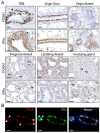FOXA1 is an essential determinant of ERalpha expression and mammary ductal morphogenesis
- PMID: 20501593
- PMCID: PMC2875844
- DOI: 10.1242/dev.043299
FOXA1 is an essential determinant of ERalpha expression and mammary ductal morphogenesis
Abstract
FOXA1, estrogen receptor alpha (ERalpha) and GATA3 independently predict favorable outcome in breast cancer patients, and their expression correlates with a differentiated, luminal tumor subtype. As transcription factors, each functions in the morphogenesis of various organs, with ERalpha and GATA3 being established regulators of mammary gland development. Interdependency between these three factors in breast cancer and normal mammary development has been suggested, but the specific role for FOXA1 is not known. Herein, we report that Foxa1 deficiency causes a defect in hormone-induced mammary ductal invasion associated with a loss of terminal end bud formation and ERalpha expression. By contrast, Foxa1 null glands maintain GATA3 expression. Unlike ERalpha and GATA3 deficiency, Foxa1 null glands form milk-producing alveoli, indicating that the defect is restricted to expansion of the ductal epithelium, further emphasizing the novel role for FOXA1 in mammary morphogenesis. Using breast cancer cell lines, we also demonstrate that FOXA1 regulates ERalpha expression, but not GATA3. These data reveal that FOXA1 is necessary for hormonal responsiveness in the developing mammary gland and ERalpha-positive breast cancers, at least in part, through its control of ERalpha expression.
Figures







References
-
- Abramoff M. D., Magelhaes P. J., Ram S. J. (2004). Image Processing with ImageJ. Biophotonics International 11, 36-42
-
- Asselin-Labat M. L., Sutherland K. D., Barker H., Thomas R., Shackleton M., Forrest N. C., Hartley L., Robb L., Grosveld F. G., van der Wees J., et al. (2007). Gata-3 is an essential regulator of mammary-gland morphogenesis and luminal-cell differentiation. Nat. Cell Biol. 9, 201-209 - PubMed
-
- Badve S., Turbin D., Thorat M. A., Morimiya A., Nielsen T. O., Perou C. M., Dunn S., Huntsman D. G., Nakshatri H. (2007). FOXA1 expression in breast cancer-correlation with luminal subtype A and survival. Clin. Cancer Res. 13, 4415-4421 - PubMed
-
- Behr R., Brestelli J., Fulmer J. T., Miyawaki N., Kleyman T. R., Kaestner K. H. (2004). Mild nephrogenic diabetes insipidus caused by Foxa1 deficiency. J. Biol. Chem 279, 41936-41941 - PubMed
-
- Besnard V., Wert S. E., Kaestner K. H., Whitsett J. A. (2005). Stage-specific regulation of respiratory epithelial cell differentiation by Foxa1. Am. J. Physiol. Lung Cell Mol. Physiol. 289, L750-L759 - PubMed
Publication types
MeSH terms
Substances
Grants and funding
LinkOut - more resources
Full Text Sources
Other Literature Sources
Medical
Molecular Biology Databases
Research Materials

